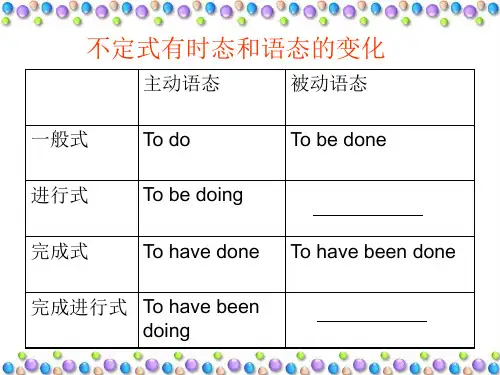英语非谓语动词教学PPT
合集下载
非谓语动词_动词不定式课件.ppt

To live is to do something worthwhile.
To listen closely and reply well is the highest perfection in the art of conversation.
不定式作主语,可以放在句首,也可以用 it 作形式主语,将真正主语不定式 放在句 末 It is important to learn the right habits
以不带to的不定式作宾补的常用动词
see, watch, hear, feel, notice observe, look at, listen to, have, make let. discover
不定式作插入语
To tell you the truth, this is all Greek to me.
不定式作状语
1.不定式表目的 To do a good job, we must have the right ways. I’ll write down his telephone number in order to call h left, never to return. She was not old enough to understand all that. 3. 不定式表原因
动词不定式作宾语时放在句中,也可以用 it 作形式宾语,真正的宾语动词不定式放 在句末.
We thought it better to start early.
They consider it important to get his permission
不定式作表语
The next step is to make sure that you know exactly what is required.
To listen closely and reply well is the highest perfection in the art of conversation.
不定式作主语,可以放在句首,也可以用 it 作形式主语,将真正主语不定式 放在句 末 It is important to learn the right habits
以不带to的不定式作宾补的常用动词
see, watch, hear, feel, notice observe, look at, listen to, have, make let. discover
不定式作插入语
To tell you the truth, this is all Greek to me.
不定式作状语
1.不定式表目的 To do a good job, we must have the right ways. I’ll write down his telephone number in order to call h left, never to return. She was not old enough to understand all that. 3. 不定式表原因
动词不定式作宾语时放在句中,也可以用 it 作形式宾语,真正的宾语动词不定式放 在句末.
We thought it better to start early.
They consider it important to get his permission
不定式作表语
The next step is to make sure that you know exactly what is required.
非谓语动词(动词ing形式和动词ed形式)课件

03
Hale Waihona Puke 动词ed形式可以作为状 语,表示动作发生的时 间、原因、条件等。
04
例如:He was born in 1990.(他出生于1990 年。)
动词ed形式与分词的区别
动词ed形式与分词在语法功能和用法 上存在显著差异。
例如:I have seen the movie.(我 已经看过这部电影了。)(动词ed形 式)
动词ing形式表示正在进行的动作或行为,而动名词表示已经完成或结果的状态。
动词ing形式在句子中做主语或表语时,表示一个动作或行为,而动名词则表示一个 名词概念。
03 动词ed形式
动词ed形式的构成
动词ed形式由动词原形加-ed构成,规则动词的-ed形式一般直接在词尾加-ed。 例如:work -> worked,play -> played。
表示被动关系
如"The book was written by him."。
表示习惯或经常性的行为
如"He likes reading books."。
表示时间或条件状语
如"If you study hard, you will succeed."。
动词ing形式与动名词的区别
动词ing形式既可以作为谓语的一部分,也可以作为独立成分,而动名词只能作为谓 语的宾语或表语。
非谓语动词的语态
主动语态
表示非谓语动词所表示的动作是 由句子主语发出来的。
被动语态
表示非谓语动词所表示的动作不 是由句子主语发出来的,而是被 其他人或物完成的。
非谓语动词时态和语态的用法
过去分词可以用于描述已经完成 的动作或存在的状态,常与时间 状语连用,如“已经”、“已经 完成”、“已经达到”等。
非谓语动词完整ppt课件完整版

同一概念的不同方面。
08 非谓语动词的常见错误及解析
误用非谓语动词代替谓语动词
混淆概念
非谓语动词和谓语动词在英语句子中扮演不同的角色,不能互相替换。非谓语 动词主要起修饰、补充或说明的作用,而谓语动词则是句子的核心,表达主语 的动作或状态。
错误用法
在句子中,非谓语动词不能单独作为谓语使用,否则会导致语法错误。例如, “He enjoying the music.”这句话中,enjoying是非谓语动词,不能作为谓 语,应改为“He is enjoying the music.”
由动词+ing构成,表示一般的、抽象 的、习惯性的动作或状态,具有名词 的性质。
非谓语动词与谓语动词的区别
谓语动词是句子的核心,表示主语的 动作或状态,具有时态、语态、主谓 一致等变化。
谓语动词在句中只能有一个,而非谓 语动词可以有一个或多个。
非谓语动词在句中作为其他成分,不 受主语人称和数的限制,也不具有时 态和语态的变化。
非谓语动词具有动词的性质,可以表示 动作、状态或属性,但不具有时态和语 态的变化。
非谓语动词的种类
不定式
由to+动词原形构成,表示一次性的 动作或未发生的动作,具有目的、原 因、结果等意义。
动名词
分词
包括现在分词和过去分词,分别由动 词+ing和动词+ed构成,表示主动和 被动的动作或状态,常用作定语和状 语。
作状语和补语
不定式作状语
表示目的、结果或原因,如:He worked hard to pass the exam. / He is too young to go to school.
分词作状语
现在分词表示主动或进行,过去分词表示被动或完成,如: Seeing the cat, the mouse ran away. / Heated, water will boil.
08 非谓语动词的常见错误及解析
误用非谓语动词代替谓语动词
混淆概念
非谓语动词和谓语动词在英语句子中扮演不同的角色,不能互相替换。非谓语 动词主要起修饰、补充或说明的作用,而谓语动词则是句子的核心,表达主语 的动作或状态。
错误用法
在句子中,非谓语动词不能单独作为谓语使用,否则会导致语法错误。例如, “He enjoying the music.”这句话中,enjoying是非谓语动词,不能作为谓 语,应改为“He is enjoying the music.”
由动词+ing构成,表示一般的、抽象 的、习惯性的动作或状态,具有名词 的性质。
非谓语动词与谓语动词的区别
谓语动词是句子的核心,表示主语的 动作或状态,具有时态、语态、主谓 一致等变化。
谓语动词在句中只能有一个,而非谓 语动词可以有一个或多个。
非谓语动词在句中作为其他成分,不 受主语人称和数的限制,也不具有时 态和语态的变化。
非谓语动词具有动词的性质,可以表示 动作、状态或属性,但不具有时态和语 态的变化。
非谓语动词的种类
不定式
由to+动词原形构成,表示一次性的 动作或未发生的动作,具有目的、原 因、结果等意义。
动名词
分词
包括现在分词和过去分词,分别由动 词+ing和动词+ed构成,表示主动和 被动的动作或状态,常用作定语和状 语。
作状语和补语
不定式作状语
表示目的、结果或原因,如:He worked hard to pass the exam. / He is too young to go to school.
分词作状语
现在分词表示主动或进行,过去分词表示被动或完成,如: Seeing the cat, the mouse ran away. / Heated, water will boil.
非谓语动词超详细讲解ppt课件

动名词的形式
动名词既有普通形式,也有完成形式和被动形式。完成形式表示动作已经完成, 如having read;被动形式表示动作被承受,如being written。
动名词在句子中的成分
动名词也可以作表语,用来描述 主语的内容或性质,如Her job is teaching English.
动名词还可以作定语,修饰名词, 如a reading room, a swimming pool等。
非谓语动词超详用法与功能 • 动名词的用法与功能 • 分词的用法与功能 • 独立主格结构的用法与功能 • 非谓语动词的注意事项与误区
01
非谓语动词概述
Chapter
定义与作用
定义
非谓语动词是指在句子中不充当谓 语的动词,包括不定式、动名词和 分词三种形式。
独立主格结构的时态和语态
时态
独立主格结构的时态主要根据句子中的谓语动词来确定。如果谓语动词是现在时或将来 时,独立主格结构用现在分词;如果谓语动词是过去时,独立主格结构用过去分词。
语态
独立主格结构的语态分为主动语态和被动语态。当独立主格结构的逻辑主语与非谓语动 词之间是主动关系时,用主动语态;当逻辑主语与非谓语动词之间是被动关系时,用被 动语态。例如:“The problem being settled, we all felt relieved.”(问题解决了,
我们都感到松了一口气。)
06
非谓语动词的注意事项与误区
Chapter
非谓语动词使用时需要注意的问题
动词不定式、动名词和分词的区别
01
在使用非谓语动词时,需要根据语境和表达的逻辑关系选择适
当的非谓语动词形式。
时态和语态的正确使用
02
动名词既有普通形式,也有完成形式和被动形式。完成形式表示动作已经完成, 如having read;被动形式表示动作被承受,如being written。
动名词在句子中的成分
动名词也可以作表语,用来描述 主语的内容或性质,如Her job is teaching English.
动名词还可以作定语,修饰名词, 如a reading room, a swimming pool等。
非谓语动词超详用法与功能 • 动名词的用法与功能 • 分词的用法与功能 • 独立主格结构的用法与功能 • 非谓语动词的注意事项与误区
01
非谓语动词概述
Chapter
定义与作用
定义
非谓语动词是指在句子中不充当谓 语的动词,包括不定式、动名词和 分词三种形式。
独立主格结构的时态和语态
时态
独立主格结构的时态主要根据句子中的谓语动词来确定。如果谓语动词是现在时或将来 时,独立主格结构用现在分词;如果谓语动词是过去时,独立主格结构用过去分词。
语态
独立主格结构的语态分为主动语态和被动语态。当独立主格结构的逻辑主语与非谓语动 词之间是主动关系时,用主动语态;当逻辑主语与非谓语动词之间是被动关系时,用被 动语态。例如:“The problem being settled, we all felt relieved.”(问题解决了,
我们都感到松了一口气。)
06
非谓语动词的注意事项与误区
Chapter
非谓语动词使用时需要注意的问题
动词不定式、动名词和分词的区别
01
在使用非谓语动词时,需要根据语境和表达的逻辑关系选择适
当的非谓语动词形式。
时态和语态的正确使用
02
非谓语动词讲课PPT

4 ___B___, you need to give all you have and try
your best. A. Being a winner B. To be a winner C. Be a winner D. Having been a winner
5. The play ___C___ next month aims mainly to
5.不定式作宾语补足语
• 跟不定式作宾语补足语的动词 • A. let, have, make, get等表使役的动词 • They made us go with them. • 注意: • Let/ have/make sb. do ; get sb. to do • They got us to go with them. • B. ask, tell, request, order等表要求,命
• Would you be so kind as to step this way, please?
• I tried the door, only to find it locked inside.
Practice 考点点击
1 Schools across China are expected to hire 50,000 college graduates this year as short-term teachers, almost three times the
子后部去. It is a great pleasure to play basketball.
2. 作宾语
• A. 跟不定式作宾语的常见动词:
• (1)hope, want , expect, wish, desire, like, love, dislike ,hate, plan, intend, mean, prepare, decide, determine, afford, fail, manage, try、dare, help , promise、 refuse、 learn、offer、 agree、 forget ,bother .
高中英语非谓语动词课件(70张)

She came here to study English.
主语
宾语 表语
定语 状语
I warned the patient not to eat cold water
after the operation.
宾补
(1)作主语 不定式做主语时, 可以直接放在谓语动词之前。
To see is to believe.
Subject+ find/think/feel/make/ consider… it +adj/n + to do sth.
1.We thought ___ better ___ start early. 2.Do you consider ___ better not __ go? 3. I feel __ my duty __ change all that. 4.We think __ important __ obey the law. 5.I know __ impossible __ finish so much homework in a day.
句型3: It is adj. for/of sb. to do sth.
It is + adj + for sb to do sth (是形容事物的性质的 ) It is + adj + of sb to do sth (是形容人的品质的 )
It is easy for me to finish this work before ten. It is a great honor for us to be present at your birthday party.
make let have
do + sb. + doing
主语
宾语 表语
定语 状语
I warned the patient not to eat cold water
after the operation.
宾补
(1)作主语 不定式做主语时, 可以直接放在谓语动词之前。
To see is to believe.
Subject+ find/think/feel/make/ consider… it +adj/n + to do sth.
1.We thought ___ better ___ start early. 2.Do you consider ___ better not __ go? 3. I feel __ my duty __ change all that. 4.We think __ important __ obey the law. 5.I know __ impossible __ finish so much homework in a day.
句型3: It is adj. for/of sb. to do sth.
It is + adj + for sb to do sth (是形容事物的性质的 ) It is + adj + of sb to do sth (是形容人的品质的 )
It is easy for me to finish this work before ten. It is a great honor for us to be present at your birthday party.
make let have
do + sb. + doing
非谓语动词ppt课件
被动语态
非谓语动词在被动语态中表示动 作的承受者。
05
非谓语动词的独立主格结构
独立主格结构的构成
01
独立主格结构由名词或代词作为 主语,后面接非谓语动词(不定 式、动名词或分词)构成。
02
独立主格结构中的非谓语动词可 以表示动作、状态或关系。
独立主格结构的句法功能
独立主格结构可以作为状语,修饰主 句中的谓语动词,表示动作发生的时 间、条件、原因、伴随情况等。
练习题三
总结词
掌握非谓语动词在句子中的用法
详细描述
通过练习题三,学生可以学习如何在句子中正确使用 非谓语动词。非谓语动词在句子中可以作为主语、宾 语、定语、状语等成分,学生需要掌握这些用法,以 便能够正确理解和运用非谓语动词。
THANKS
感谢观看
功能
总结词
非谓语动词在句子中起到修饰、补充或说明的作用。
详细描述
非谓语动词可以作为句子的补语,补充说明主语或宾语的状态或行为,如“I like reading books”。非谓语动词还可以作为定语,修饰名词或代词,如“the reading room”。此外,非谓语动词还可以作为状语,表示动作的方式、时间、条件等,如“I
非谓语动词ppt课件
contents
目录
• 非谓语动词概述 • 非谓语动词的种类 • 非谓语动词的用法 • 非谓语动词的时态和语态 • 非谓语动词的独立主格结构 • 非谓语动词的练习与解析
01
非谓语动词概述
定义
总结词
非谓语动词是指在句子中不作谓语的动词,包括不定式、动名词和分词等形式 。
详细描述
非谓语动词是英语语法中的一个重要概念,指的是在句子中不作为主要谓语使 用的动词。非谓语动词可以表示动作、状态或行为,但它们在句子中起到修饰 、补充或说明的作用,而不是作为句子的核心行为。
非谓语动词在被动语态中表示动 作的承受者。
05
非谓语动词的独立主格结构
独立主格结构的构成
01
独立主格结构由名词或代词作为 主语,后面接非谓语动词(不定 式、动名词或分词)构成。
02
独立主格结构中的非谓语动词可 以表示动作、状态或关系。
独立主格结构的句法功能
独立主格结构可以作为状语,修饰主 句中的谓语动词,表示动作发生的时 间、条件、原因、伴随情况等。
练习题三
总结词
掌握非谓语动词在句子中的用法
详细描述
通过练习题三,学生可以学习如何在句子中正确使用 非谓语动词。非谓语动词在句子中可以作为主语、宾 语、定语、状语等成分,学生需要掌握这些用法,以 便能够正确理解和运用非谓语动词。
THANKS
感谢观看
功能
总结词
非谓语动词在句子中起到修饰、补充或说明的作用。
详细描述
非谓语动词可以作为句子的补语,补充说明主语或宾语的状态或行为,如“I like reading books”。非谓语动词还可以作为定语,修饰名词或代词,如“the reading room”。此外,非谓语动词还可以作为状语,表示动作的方式、时间、条件等,如“I
非谓语动词ppt课件
contents
目录
• 非谓语动词概述 • 非谓语动词的种类 • 非谓语动词的用法 • 非谓语动词的时态和语态 • 非谓语动词的独立主格结构 • 非谓语动词的练习与解析
01
非谓语动词概述
定义
总结词
非谓语动词是指在句子中不作谓语的动词,包括不定式、动名词和分词等形式 。
详细描述
非谓语动词是英语语法中的一个重要概念,指的是在句子中不作为主要谓语使 用的动词。非谓语动词可以表示动作、状态或行为,但它们在句子中起到修饰 、补充或说明的作用,而不是作为句子的核心行为。
高中英语——非谓语动词课件(共34张PPT)
定 式 与
It is not likely that she has got our letter.
从
= She is not likely to have got our letter.
句
advise allow permit forbid
sb. to do sth.
advise allow permit forbid
1 不定式作定语宾语和状语的特点 2 动名词的特点 3 动名词和不定式作宾语的区别 4 分词与不定式作定语的区别 5 现在分词和过去分词作表语定语的区别 6 过去分词现在分词作补语的区别 7 非谓语动词的时态语态 8 非谓语动词与从句的关系 9 非谓语动词的逻辑主语独立式否定式
非
特共 点点
句中的作用
2. There is something t(ofodrosomebody) to do. There is a letter to write. There is no time to lose. There is something to pay attention to. Will you attend the lecture to be given next week?
(状语)
不定式与所修饰名词有逻辑上的动宾关系
1. n. / pron. + Mary has 逻辑主
to Vt. to Vi + prop. three babies to look after. 逻辑宾
Please buy me some newspapers to read. 逻辑主 逻辑宾
He always has a lot of meetings to attend. Please pass me some paper to write on.
《非谓语动词》课件(共12张PPT)
定语从句中的非谓语动词
在定语从句中,非谓语动词可以用来修饰名词或代词,表示名词或代词 的状态或特征。
非谓语动词在定语从句中的使用可以使句子更加生动形象,增强语言的 表达力。
需要注意的是,非谓语动词在定语从句中的使用需要遵循一定的语法规 则和习惯,不能随意使用。同时,与定语从句中的其他成分一起构成完 整的意义。
独立主格结构
独立主格结构是一种特殊的句式,其 中非谓语动词与主句的主语没有明确 的逻辑关系,而是通过独立的主语来 表达完整的意义。
常见的独立主格结构包括名词/代词+ 非谓语动词、名词/代词+形容词、名 词/代词+副词等。
独立主格结构通常用于描述一个独立 的事件或状态,与主句之间用逗号或 分号隔开,有时也可以省略独立主格 结构中的主语和谓语。
不定式是由“to + 动词原形” 构成的,在句子中不充当谓语
,而是作为其他成分使用。
不定式的时态和语态
不定式可以有多种时态和语态 ,包括一般式、进行式、完成 式和被动式。
不定式的功能
不定式可以作为主语、宾语、 定语、状语和补语等,在句子 中发挥不同的作用。
不定式的否定形式
不定式的否定形式是在“to”前 面加上“not”,例如“not to
详细描述
非谓语动词在句子中起到丰富句子结构和表达多样性的作用 。它们可以代替从句,使句子更加简洁明了。同时,非谓语 动词还可以表达动作的主动和被动关系,以及动作的完成和 进行状态等。
02 非谓语动词的时态和语态
主动语态
主动语态表示主语是 动作的执行者。
主动语态常用于描述 主语执行的动作,强 调主语的主动性和积 极性。
THANKS FOR WATCHING
非谓语动词(共110张PPT)
02 非谓语动词的时态和语态
主动语态
主动语态表示非谓语动词与逻辑主语之间为主动关系,即非谓语动词的动作是由逻 辑主语发起的。
在主动语态中,非谓语动词可以根据需要选择不定式、现在分词和过去分词形式。
不定式可以表示将来的动作,现在分词表示正在进行的动作,过去分词表示完成的 动作。
被动语态
被动语态表示非谓语动词与逻辑 主语之间为被动关系,即非谓语 动词的动作不是由逻辑主语发起
语态错误
总结词
语态错误是指非谓语动词在使用中没 有正确地表达出被动关系。
详细描述
非谓语动词有主动语态和被动语态两 种形式,需要根据语境选择正确的语 态。如果句子中的主语是动作的承受 者,应该使用被动语态的非谓语动词 形式。
用法错误
总结词
用法错误是指非谓语动词在使用中没有遵循正确的语法规则和习惯用法。
的。
在被动语态中,非谓语动词同样 可以根据需要选择不定式、现在
分词和过去分词形式。
不定式被动语态可以表示将来的 动作,现在分词被动语态表示正 在进行的动作,过去分词被动语
态表示完成的动作。
时态
01
02
非谓语动词的时态主要 通过其形式变化来表示 动作发生的时间和状态。
不定式可以根据时态变 化而变化,如一般式、 完成式、进行式等。
04 非谓语动词的特殊用法
独立主格结构
定义
独立主格结构是一种特殊的句式, 其中非谓语动词与主句的主语没 有逻辑上的主谓关系,而是独立 存在。
用法
通常用于描述完成、进行或将来发 生的动作,表达时间、条件、原因 等逻辑关系。
示例
The work finished, we went home.(工作完成后,我们回家 了。)
- 1、下载文档前请自行甄别文档内容的完整性,平台不提供额外的编辑、内容补充、找答案等附加服务。
- 2、"仅部分预览"的文档,不可在线预览部分如存在完整性等问题,可反馈申请退款(可完整预览的文档不适用该条件!)。
- 3、如文档侵犯您的权益,请联系客服反馈,我们会尽快为您处理(人工客服工作时间:9:00-18:30)。
crossing the street. 定语
3. When you hang wet clothes near
a fire, you will see steam rising
from them. 宾补
4. Not knowing much English, I
found it hard to understand
5).定语 想不想要一些喝的东西?
Would you like something to drink?
*不定式做定语往往位于所修饰 的名词的后面。
他是第一个来的老师。 He was the first teacher to come.
请给我一张纸写字。 Please give me a piece of paper to
to answer
动词不定式省略to的情况(P215)
①同一结构并列,由and 或or连接 He asked me to come in and sit
down ②含有行为动词do 的句子中,作表语
用的不定式to可以省略. All you need to do is (to) say sorry
to him. ③介词but, except, besides前有实意
D. being writing.
2. Now he is disappointed to scold his son yesterday. (Correction)
have scolded
B 3. They are said ___another bridge these days.
A. to build
C C. not to eat D. not eat
John was made ___ the truck for a
week as a punishment.
A.to wash A B. washing
C. wash
D. to be washing
在感观动词 使役动词中的用法
He was made to work from morning till night.
2).作表语
He seemed to be shy before the
public. 注意:不定式作联系动词be的表 语且主语部分含有实义动词do 时,to可以省略。
The first thing I did was (to) say
sorry to him.
3).作宾语 作及物动词的宾语,常用的及
要同时保留be或have. e.g. --- Have you visited Mr.
Smith in hospital? --- Not yet, but I’m going to.
--- Are you on holiday? --- No, but I’d like to be.
V-ing
1.作主语 2.作宾语 3.作表语 4.作补语
Jtoapcalonseeseth.(e宾(do语宾or)补. )
5).What a lot of invitations to send
out!
(定语)
6). One day I went shopping and
came back to find my front wheel
was missing.
A. to have found B. finding
C. found
D D. to find
不定式的各种 形式
1一般式(to do)表示的动作或状态, 发生在谓语动词表示的动作或状 态的同时或之后
2 完成式(to have done)表示动作 或状态,发生在谓语动词表示的 动作或状态之前
He is said to have gone abroad.
物动词有:ask, want, decide, seem, promise, pretend, agree, wish, afford, fail, refuse, manage, expect, happen, offer, beg, hope, demand
Sandy could do nothing but ___ to his teacher that he was wrong.
5.作定语 6.作状语
7.v-ing复合 结构
Practice
Ex1. Point out the function of the –ing form in each sentence.
1. Doing nothing is doing ill. 2. Slow down for children主语;表语
A.admit A B. admitted C. admitting D. to admit
注意:除个别介词but, except外,不 定式不作介词宾语,但不定式在but 后面时,若前有实义动词do,不定式 不带to,否则须带to。
We have nothing to do but wait for the doctor.
4).宾补 在一些动词如advice,allow, ask,force,get…等后面做宾 语补足语。
ask sb. to do sth. allow sb. to do sth. …
The patient was warned ____ oily food after the operation. A.to eat not B. eating not
B. to be dealt
D
C. to be dealt with
D. to deal with
先判断正误,如有错则改正,最后总结提高
1.I have some questions to ask.
2.Do you have anything to take to
Beijing? I’ll leave for it tomorrow. to be taken
3进行式(to be doing)表示的动作 或状态,与谓语动词表示的动作 或状态同时发生.
The students pretended to be reading.
1. I have two letters ______now.
A.to write B. tor/ would rather/ rather than/can not help but+ 动词原形
(6)why 开头的省略句 Why not go out for a walk .
保留to,而省略其后的动词. 1.不定式to后的内容承前启后(重
复) 2. 但如果不定式后有have或be,则
write on. 注意(1)在表示次序的词:first, last, next等之后的动词要用不定式的结构
(2)如果不定式是vi动词,或不定式 所修饰的名词是不定式动作的地点、 工具等,不定式后要加上相应的介 词。
The chair looks rather hard, but
in fact it is very comfortable to
B. to be building
C. that they build
D. that they are building
4. Robert is said ____ abroad, but I
don’t know what country he
studied in. A.to have studied B. to study
3. I have no more letters to type,
thank you.
to be typed
4.The question is easy to be answered.
5. There is nothing to do now.
6. There is nothing to be done now.
--Sure, ___it completed in time,
we’ll work two more hours a day.
A. having got
B. to get C. getting
B
D. get
4. He hurried to the station only
___that the train had left.
动词do 的任何形式 You can’t do nothing but listen to
me.
④make , have, let, hear, listen to, feel, see, watch, look at, notice, observe后
He made me understand the meaning of the word. 但是:I was made to understand the meaning of the word.
into pieces. 宾语
8. They left the café, talking
and laughing loudly. 状语
(1). 作宾语 (p.104)
A)只能接v-ing为宾语的动词短语. (p.100. to 为介词)
B) have difficulty/trouble/a good/happy/hard time (in) doing sth.
_____. (NMET 1989)
B
A. sit
B. sit on
C. be sat D. be sat on
1.The fans waited outside for a
long time just___ a look at the
star. A.had
C
B. having
C. to have
C) There is no point /good/ use/harm ( in )doing
3. When you hang wet clothes near
a fire, you will see steam rising
from them. 宾补
4. Not knowing much English, I
found it hard to understand
5).定语 想不想要一些喝的东西?
Would you like something to drink?
*不定式做定语往往位于所修饰 的名词的后面。
他是第一个来的老师。 He was the first teacher to come.
请给我一张纸写字。 Please give me a piece of paper to
to answer
动词不定式省略to的情况(P215)
①同一结构并列,由and 或or连接 He asked me to come in and sit
down ②含有行为动词do 的句子中,作表语
用的不定式to可以省略. All you need to do is (to) say sorry
to him. ③介词but, except, besides前有实意
D. being writing.
2. Now he is disappointed to scold his son yesterday. (Correction)
have scolded
B 3. They are said ___another bridge these days.
A. to build
C C. not to eat D. not eat
John was made ___ the truck for a
week as a punishment.
A.to wash A B. washing
C. wash
D. to be washing
在感观动词 使役动词中的用法
He was made to work from morning till night.
2).作表语
He seemed to be shy before the
public. 注意:不定式作联系动词be的表 语且主语部分含有实义动词do 时,to可以省略。
The first thing I did was (to) say
sorry to him.
3).作宾语 作及物动词的宾语,常用的及
要同时保留be或have. e.g. --- Have you visited Mr.
Smith in hospital? --- Not yet, but I’m going to.
--- Are you on holiday? --- No, but I’d like to be.
V-ing
1.作主语 2.作宾语 3.作表语 4.作补语
Jtoapcalonseeseth.(e宾(do语宾or)补. )
5).What a lot of invitations to send
out!
(定语)
6). One day I went shopping and
came back to find my front wheel
was missing.
A. to have found B. finding
C. found
D D. to find
不定式的各种 形式
1一般式(to do)表示的动作或状态, 发生在谓语动词表示的动作或状 态的同时或之后
2 完成式(to have done)表示动作 或状态,发生在谓语动词表示的 动作或状态之前
He is said to have gone abroad.
物动词有:ask, want, decide, seem, promise, pretend, agree, wish, afford, fail, refuse, manage, expect, happen, offer, beg, hope, demand
Sandy could do nothing but ___ to his teacher that he was wrong.
5.作定语 6.作状语
7.v-ing复合 结构
Practice
Ex1. Point out the function of the –ing form in each sentence.
1. Doing nothing is doing ill. 2. Slow down for children主语;表语
A.admit A B. admitted C. admitting D. to admit
注意:除个别介词but, except外,不 定式不作介词宾语,但不定式在but 后面时,若前有实义动词do,不定式 不带to,否则须带to。
We have nothing to do but wait for the doctor.
4).宾补 在一些动词如advice,allow, ask,force,get…等后面做宾 语补足语。
ask sb. to do sth. allow sb. to do sth. …
The patient was warned ____ oily food after the operation. A.to eat not B. eating not
B. to be dealt
D
C. to be dealt with
D. to deal with
先判断正误,如有错则改正,最后总结提高
1.I have some questions to ask.
2.Do you have anything to take to
Beijing? I’ll leave for it tomorrow. to be taken
3进行式(to be doing)表示的动作 或状态,与谓语动词表示的动作 或状态同时发生.
The students pretended to be reading.
1. I have two letters ______now.
A.to write B. tor/ would rather/ rather than/can not help but+ 动词原形
(6)why 开头的省略句 Why not go out for a walk .
保留to,而省略其后的动词. 1.不定式to后的内容承前启后(重
复) 2. 但如果不定式后有have或be,则
write on. 注意(1)在表示次序的词:first, last, next等之后的动词要用不定式的结构
(2)如果不定式是vi动词,或不定式 所修饰的名词是不定式动作的地点、 工具等,不定式后要加上相应的介 词。
The chair looks rather hard, but
in fact it is very comfortable to
B. to be building
C. that they build
D. that they are building
4. Robert is said ____ abroad, but I
don’t know what country he
studied in. A.to have studied B. to study
3. I have no more letters to type,
thank you.
to be typed
4.The question is easy to be answered.
5. There is nothing to do now.
6. There is nothing to be done now.
--Sure, ___it completed in time,
we’ll work two more hours a day.
A. having got
B. to get C. getting
B
D. get
4. He hurried to the station only
___that the train had left.
动词do 的任何形式 You can’t do nothing but listen to
me.
④make , have, let, hear, listen to, feel, see, watch, look at, notice, observe后
He made me understand the meaning of the word. 但是:I was made to understand the meaning of the word.
into pieces. 宾语
8. They left the café, talking
and laughing loudly. 状语
(1). 作宾语 (p.104)
A)只能接v-ing为宾语的动词短语. (p.100. to 为介词)
B) have difficulty/trouble/a good/happy/hard time (in) doing sth.
_____. (NMET 1989)
B
A. sit
B. sit on
C. be sat D. be sat on
1.The fans waited outside for a
long time just___ a look at the
star. A.had
C
B. having
C. to have
C) There is no point /good/ use/harm ( in )doing
